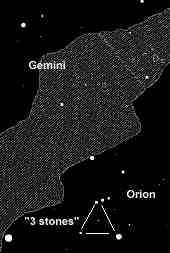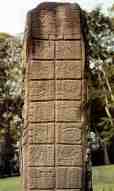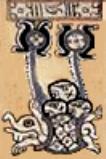
Three stones were set. They planted [the first stone], Jaguar Paddler, Stingray Paddler. . . . He planted the [second] stone, First Black Chak(?) . . . . The [third] stone was set [by] Great Itzamna. . . . It happened at Lying Down Sky.

At the centre of every traditional Maya dwelling is household hearth, a triangle of three stones. The hearthstones have a sacred as well as utilitarian function. Maya rituals often begin with the centring of the four quarters of the world about the ritual precints. Household rituals are centred on the hearthstones. The Earth-Sky, the dwelling place of humans, is centred on a cosmic hearth, from which the World Tree first rose. The Popol Vuh hints at the importance of the hearth: When the wooden people were destroyed by flood, "their hearthstones were shooting out, coming right out of the fire . . . Such was the scattering of the human work, the human design." An essential step in the reordering of the world after the deluge was the setting of the hearth stones of the new world.

Toward dawn on the night of Aug 13, the constellation Orion moves toward the zenith. The Quiche people still refer to a triad of three bright stars in Orion as "the hearth stones", and the hazy nebula below Orion's belt is called "the smoke from the hearth". Orion is also called the turtle stars (ak' ek), depicted in the Madrid Codex as a turtle with three tun ("stone") glyphs on its back. Because the sky has not yet been raised, the hearth is a location in both earth and sky. The turtle shell is an earth symbol, like the back of the crocodile at the foot of the World Tree. Here is the place of Creation, where the sky will rise again.

Maya Constellations. Although Orion is clearly associated with the hearth and turtle, the Paris Codex Zodiac appears to equate the turtle stars with Gemini. Elsewhere, both Gemini and Orion appear to be identified with a pair of peccaries. Both the turtle and the peccary are earth symbols, and both are named ak in some Mayan languages. Schele assigns the turtle to Orion, and the peccaries to Gemini, but it may be that the Maya identified Orion and Gemini, which together straddle both the ecliptic and Milky Way, as a single region of the sky.
Image: Turtle (ak) constellation and the three stones (ox tun) of creation hang from a skyband representing the ecliptic
The beginning of the long count in 3114 BC, long before the rise of Maya civilization, marks the date of Creation. But on the handful of Classical monuments that memorialize events of the mythic age, Creation is written 13.0.0.0.0, the completion of 13 baktuns, a period of about 5125 years. This suggests that the present age followed an earlier world that endured 13 baktuns. An inscription at Coba records even earlier epochs, counting back for some 13 x 2021 years.
The Popol Vuh preserved this tradition of successive creations or world orders. According to the Popol Vuh, the gods created humans to honour them: There would be "no high days and no bright praise for our work, our design, until the rise of the human work, the human design". But their first three efforts were failures. The third failed race, people fashioned from wood, were destroyed in a universal flood.
The antediluvian world was lorded over by Vukub-Cakix, "Seven Macaw," who took the place of the sun. To prepare for the creation of the true humans, the rule of Seven Macaw had to be ended. This was achieved by the Hero Twins of the Popol Vuh, who shot Seven Macaw from his tree.
The Quiche still identify the seven stars of the Big Dipper with Seven Macaw. At sunset on August 13, the Milky Way is nearly erect, and the Dipper is visible in the the northern sky in the Maya area. But as the heavens rotate, the Milky Way turns away from its upright position, and the Dipper dives toward the horizon. About two hours after sunset, the Dipper sets: Seven Macaw is knocked from his perch atop the World Tree. Dennis Tedlock reports that among the Quiche, the mid-summer descent of the Dipper just after sunset marks the beginning of the hurricane season, the time of flooding.
The sky of the old order fell when Seven Macaw was knocked from his perch and the deluge destroyed the wooden people. The sky of the new world could only be raised by an act of sacrifice. The gods created the new world through their sacrifice. Their blood nourished the World Tree. Ritual renews the world, recapitulating the ordering of the cosmos at Creation. The Maya, like other Mesoamerican peoples, believed that blood sacrifices offered by humans repay their debt to the gods.
Although Maya creation accounts differ in detail, most tell of the defeat and sacrifice of one or more gods by the lords of the Underworld. In the Books of Chilam Balam, the gods of the thirteen heavens are captured and sacrificed by the nine gods of the Underworld. In the Popol Vuh, the maize god, Hun Hunaphu, the father of the hero twins, journeys to the Underworld, where he is defeated by its rulers in a ritual ball game and sacrificed. In the Dresden Codex, sacrifice of the maize god appears to be the very act that raises the sky of the new world. In the Popol Vuh, he is rescued by his sons, and it is his resurrection that renews of the world.
The Milky Way/World Tree is the route between the heavens, earth, and Underworld. On the sarcophagus of Pakal at Palenque, the dead king is shown falling along the World Tree, named here sak be, "white road." The Quiche still call the Milky Way Xibalba be "road to the Underworld;" The Chorti Maya call it Camino de Santiago.
By midnight on August 13, the Milky Way runs across the sky from east to west. It now represents the fallen sky. A great dark bite is visible in the Milky Way, which Schele sees as the maw of the crocodile at the foot of the Izapa World tree, a gateway to the Underworld. This is the "cross-roads" at which Hun Hunaphu disappeared when he took the "Black Road" to Xibalba.
These roads are sometimes imagined as canoe routes. About three hours after midnight, Schele identifies the visible portion of the Milky Way with the cosmic canoe, illustrated in Classic Maya art, that conveys the maize god through the Underworld to the place where he will be resurrected, the hearth of Creation in Orion. Here the sky of the new era will be raised. Later, as the Milky Way begins to turns upright again, the canoe appears to sink.






























